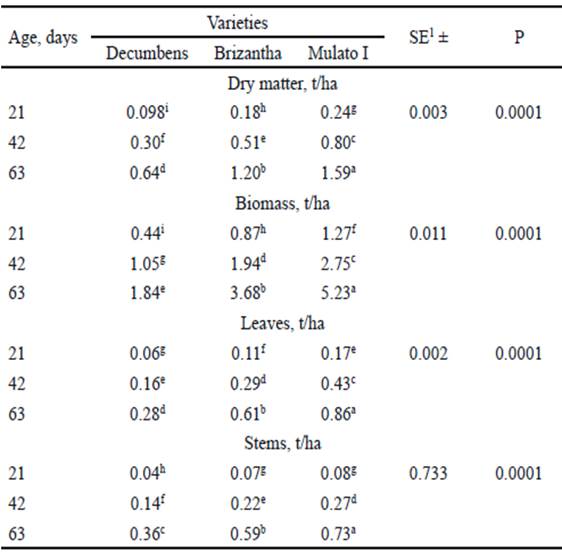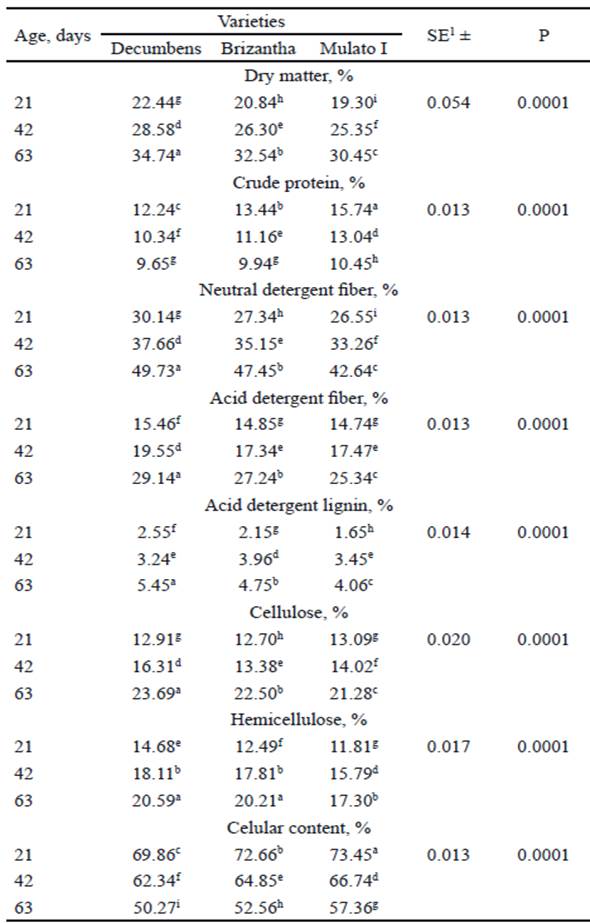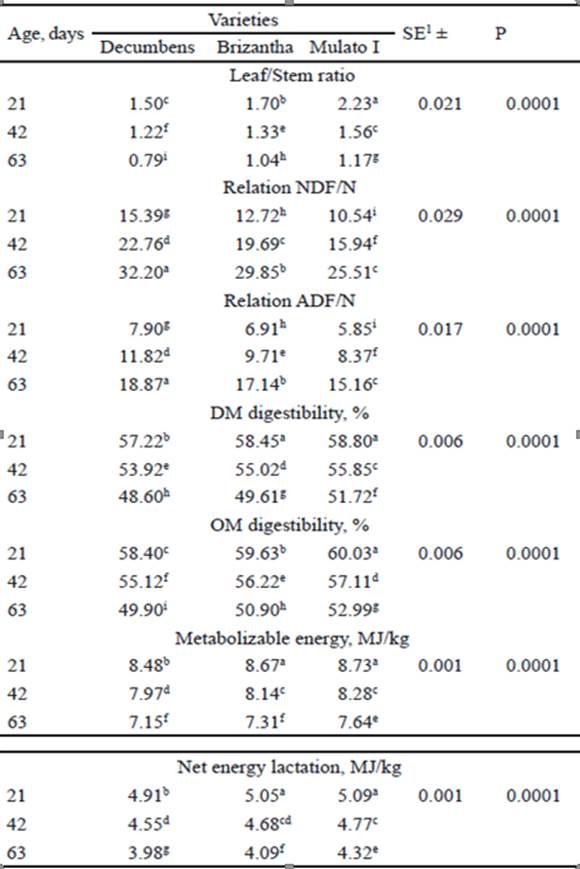INTRODUCTION
The economic activity in tropical countries has been centered in the agricultural field, with emphasis on bovine livestock under an extensive production system, naturalized grasses with the use to a lesser extent those introduced or improved (López et al. 2018).
The low productivity of grasslands is one of the most important limitations in the feeding system for the cattle in the Ecuadorian tropics. The areas are sown with forage species such as Brachiaria humidicola and have limitations in productivity, adaptability and persistence in these environments; in addition, it is susceptible to spittlebug from grasses caused by Aeneolamia spp. and foliar fungi such as Rizoctonia solani, which significantly reduces its yield (Álvarez et al. 2013). However, new cultivars of the Brachiaria genus have been launched to the market to overcome the observed problems in traditional forages and thus provide better options for farmers (Pizarro et al. 2013).
In Ecuador, several cultivars of Brachiaria spp. have been introduced, which have the potential to increase the productivity of existing grasses systems. Among them are Decumbens, Brizantha and Mulato I, from which there are some reports on their acceptance by farmers due to their high nutritional value, adaptation to a wide range of soils and tolerance of pests and diseases (Garay et al. 2017).
The productive capacity and quality of forage species can be affected by some factors such as: use of different genotypes or cultivars, age of the plants and weather conditions (Lara et al. 2010). Therefore, it is necessary to know the productive performance of new promising Brachiaria varieties, as well as their nutritional contribution in different edaphoclimatic conditions. Hence, the objective of this study was to evaluate the quality of three Brachiaria cultivars in Guayas area, Ecuador at different regrowth ages.
MATERIALS AND METHODS
Location. This research was carried out in El Mamey farm, located in El Ají sector, Guayas parish, Guayas province, Ecuador. It is located between the geographic coordinates 01° 00' of south latitude and 79° 30 of west longitude at 75 m.o.s.l. The research was conducted in the period between July-September (dry season) of 2015.
Agrometeorological conditions. The climate of the territory is classified as humid subtropical (Köppen 1931), with rainfalls of 117.2mm during the experimental period. The average, maximum and minimum temperature is: 23.87; 29.17 and 21.03°C, respectively and relative humidity 79 %, indicators that are within the range of the historical average until 2014 (116.32 mm, 22.4, 29.52, 21.1°C for the average, maximum and minimum temperature and 75.6 % of relative humidity). The soil of the area is Inceptisol (Soil Survey Staff 2003) and its chemical composition is in table 1.
Treatment and experimental design. A random block design with factorial arrangement (3x3) was used: three Brachiaria cultivars (decumbens, brizantha and mulato I) and three regrowth ages (21, 42 and 63 days) and five replications.
Procedure. The experimental plots (5x5 = 25m2) of Brachiaria decumbens, Brachiaria brizantha and Brachiaria decumbens x Brachiaria ruziziensis cv. Mulato I were sowing in February 2015, at a distance of 50 cm between rows and 20 cm between plants. The plants had a period of establishment until July, where the uniformity cut was made. From there, samplings at 21, 42 and 63 days of regrowth were made, eliminating 50 cm of border effect and cutting all the material from the harvestable area at 10 cm above soil level. The biomass production, in total dry matter yield, of leaves and stems, number of leaves and stems (by bunch), as well as the length and width of leaves, and the leaf-stem ratio were evaluated (Herrera 2006). Then two kilograms (two samples) were taken for each of the treatments and replications for further analysis in the laboratory.
Only irrigation was used to facilitate germination and establishment, and no fertilization or chemical treatment was used to eliminate weeds. At the beginning of the experiment, the population of the varieties in the plots was 95 %.
Determination of chemical composition. The DM, CP, ash, OM, P and Ca were determined according to AOAC (2000); NDF, ADF, ADL, cellulose (Cel), hemicellulose (Hcel) and cellular content (CC) according to Goering and Van Soest (1970)); the digestibility of dry matter was quantified by Aumont et al. (1995); and the metabolizable energy and net lactation energy were established according to Cáceres and González (2000). All analyzes were performed in duplicate and by replication.
Statistical analysis and calculations. Analysis of variance was performed according to the experimental design and mean values were compared using Duncan (1955) multiple range test. For the normal distribution of the data the Kolmogorov-Smirnov (Massey 1951) test was used and for the variances the Bartlett (1937) test.
RESULTS
Table 2 shows the results of the yield where there was interaction (P <0.0001) between variety x regrowth age. The highest results were obtained in Mulato I at 63 days with 5.23 t/ha for biomass, 1.59; 0.86 and 0.73 tDM/ha for the total yield of leaves and stems, respectively.
Table 2 Components of the yield of three Brachiaria varieties

abcdefg Values with uncommon letters differ at P <0.05 (Duncan 1955)
1SE, standard error of the interaction variety x age
The morphological components (table 3) maintained similar performance to yield, with the best results for Mulato I at 63 days (0.68 m, 467.50, 0.54m and 0.037 m, for height, number of leaves, leaves length and leaves width, respectively) but the Decumbens showed the highest number of stems (128.25) at that same age.
The Decumbens variety at 63 d (table 4) recorded high fibrous content (NDF, ADF, ADL, Cel and Hcel with 49.73, 29.14, 5.45, 23.69 and 20.59 %, respectively). While Mulato I at 21 days recorded the best percentages for crude protein and cellular content (15.74 % and73.45 %, respectively).
Table 3 Morphological indicators of three Brachiaria varieties

abcdefghi Values with uncommon letters differ at P<0.05 (Duncan 1955)
1SE, standard error of the interaction variety x age
Table 4 Protein content and fibrous fractionation of three Brachiaria varieties

abcdefghi Values with uncommon letters differ at P<0.05 (Duncan 1955)
1SE, standard error of the interaction variety x age
Variety x regrowth age (table 5) showed significant interaction for the content of minerals and organic matter. The ashes and P (16.15, 0.06 7 %) were higher for Decumbens variety at 63 days; for Brizantha the Ca (0.88 %) at this same age and the OM for Mulatto I at 21 d (89.54 %).
For the quality (table 6) Mulato I variety with 21 days of regrowth showed the best results of the leaf/stem ratio, DMD, OMD, ME and LNE with values of 2.23, 58.80 % 60.03 %, 8.73 MJ/kg and 5.09 MJ/kg; while at 63 days the Decumbens showed the highest values for the relations (NDF/N and ADF/N, 32.20 and 18.87, respectively).
Table 5 Tenors of minerals and organic matter of three Brachiaria varieties

abcdefghiValues with uncommon letters differ at P<0.05 (Duncan 1955)
1SE, standard error of the interaction variety x age
DISCUSSION
In tropical grasses the dry matter production depends on the balance between the photosynthetic rate and the respiration rate of the plant (Taiz and Zeiger 2010). On the other hand, it increases as the age or growth of the plant advances, with a higher growth rate of tropical species when maximum rainfalls are recorded.
Juárez-Hernández and Bolaños-Aguilar (2007) when evaluating several cultivars of Brachiaria (B. humidicola, mulato I, B. decumbens, B. dictyoneura) reported increases with the cut age of dry matter production and there were differences between varieties with the highest results for Mulato I. These results showed their potential and argued that the variation between these genotypes is attributed to the intrinsic characteristics and synthesis capacity of metabolites of each species.
On the other hand, Garay et al. (2017) in the humid tropics of Ecuador in several cultivars of Brachiaria decumbens, B. brizantha (Xaraés, Marandú, Piatá) and Mulato II, reported average yield of 6.34 t/ha at
70 d and during the rainy season there were no differences between forages, while during the dry season the cv. Xaraés showed the highest total yields (5.09 vs 3.14-3.89 t/ha of the rest of varieties) and leaves of 4.28, while for the stems it was for cv. Decumbens with 0.93 and the lowest results for Mulato II and Marandú 0.57-0.64. They concluded that the differences between cultivars in the production of leaves and stems are due to the characteristics of each cultivar. The decrease reported during the period of lower rainfalls is attributed to the effect of climatic factors such as rainfalls and temperatures. Aspects that are highlighted in this research since from an annual average of 2400 mm only occurred during the study period 117.2 mm.
Rincon et al. (2018) when evaluating the effect of fertilization on the productivity of llanero grass (Colombia) (Brachiaria humidicula) found increases of 0.31 t/ha with respect to the control treatment. On the other hand, López et al. (2018) reported in Brachiaria mutica yields of 2 t/ha, showing that the DM yield shows direct relation with the plant height variable, which shows that the increase is accompanied by an increase in the structural biomass (stems) and foliar (leaves).
The effect of the environment on the performance of the forage morphological indicators (table 3) is observed mainly when the environmental conditions are not limiting. Fleitas et al. (2017) reported growth rates of 0.133 t d-1 when edaphic and thermal conditions were favorable, while in the season of minimum rainfall they were 0.032 t d-1. The climatic conditions in the dry period limit the plants growth, mainly by the higher proportion of leaves, fundamentally, to increase the photosynthetic process, higher amount of nutrients, hence the highest use of the animal during this season.
This performance is due to the drought tolerance of the species from Brachiaria genus is determined by its phenological, anatomical and physiological characteristics. That is why these forages adapt to a wide range of edaphoclimatic conditions, such as savannas, abundant rainfalls or desert, under the action of the sun or in the shade. It is known that the mechanisms of physiological response of plants to abiotic stress help to obtain and select new varieties adapted to specific environmental conditions. The development of new cultivars with higher tolerance to water stress, higher efficiency of water use is an alternative for the adaptation of animal production systems to the effects of climate change (Santos et al. 2013).
Garay et al. (2017) when evaluating Brachiaria varieties (Piatá, Xaraés, Señal, Mulato II and Marandú) reported heights of 1.06; 1.04; 0.78; 0.76 and 0.68 m, respectively and the highest leaf index for Mulato II with 5.8 during the period of lower rainfall. While Assis et al. (2014) and Louw-Gaume et al. (2017), obtained 0.18 and 0.013 m in length and width of leaves in B. humidicola in Rio Branco, Brazil but, with average rainfalls (1877-1982 mm) well above those reported in this research. Aspects that would help to understand the studied results.
For the protein content and cell wall (table 4) there was a variety- regrowth age interaction with decreasing of CP and CC; as well as increase of DM, NDF, ADF, ADL, Cel and Hcel. When referring to the nutritional value of the forage, it is not possible to consider only the protein content, since it has a negative relation with the biomass volume and its production. In the peak rainfall season of the year, there has been a decrease in the protein content during the growth of grasses (Figueiredo et al. 2012). Therefore, some authors suggest that having a lower reduction, the protein content is concentrated in the dry season and on the contrary when suffering a higher reduction, the crude protein content undergoes a dilution during the other period. It is evident in the results reported by Assis et al. (2014) with CP levels of 7.29 found in the humidicola variety, with rainfalls over 2000mm, while cell wall values were 77.46, 41.78 and 5.35 % of NDF, ADF and ADL. Results that differ from those found in this study.
The variability of CP among genotypes and varieties of the same species in the same climatic conditions is due to the habit of growth, morphology and carbonate metabolism among other factors, these fluctuations showed in studies by Juárez-Hernández and Bolaños-Aguilar (2007) who reported in two Brachiaria varieties (Decumbens and Mulato I) percentages of 4-14 and 11-16, respectively. Garay et al. (2017) reported when evaluating several cultivars of this species the best results for Mulato II with 14.3 %, although it is important to highlight that all (Piatá, Xaraés, Señal and Marandú) exceeded 11 %. Rincon et al. (2018) found in Llanero (Colombia) cultivar percentages of CP, NDF and ADF of 9.9; 73 and 35.1 %, respectively. On the other hand, López et al. (2018) in Brachiaria mutica reported 9.4 and 26.40 % of CP and CF. These authors show that at the season of higher rainfalls there is a lower concentration of protein due to the rapid growth of foliage (maturity) and accumulation of fibrous material.
When evaluating the effect of increasing levels of nitrogen fertilization on Brachiaria decumbens and Brachiaria ruziziensisFaria et al. (2018) reported increases in CP and cell wall decrease, concluding that this performance is due to N stimulates the growth of the plant and the use of available carbohydrates for cell formation and protoplasm, instead of being used for thickening of the cell wall through the accumulation of these. Another hypothesis shows the occurrence of the dilution of this fraction, although nitrogen promotes the dry matter accumulation.
Regarding the content of minerals and organic matter (table 5) there was interaction between variety- age with increases for ash, Ca, P and OM with age. Ramírez et al. (2014) when evaluating the relation between minerals with age and climatic factors in hybrid Brachiaria cv. Mulato I found increases in Ca and decrease in P with the maturity of forage and attributed the decrease of this last element to its dilution with age and the yield increase in DM. In addition, phosphorus plays multiple roles in plant metabolism. It is considered a fundamental component since it is part of a wide range of molecules, activates different enzymes and controls metabolic processes. However, its absorption by the plant depends on the quantity and the way it is available in the soil.
The percentages of ash are within the range for Brachiaria 5.7-14 % species under normal rainfall conditions, 9 % for the dry season reported by Combatt et al. (2015) showing the ability of this species to respond to the different edaphoclimatic conditions. Similar results were obtained by Reyes-Pérez et al. (2018) for Ca, P, ash and OM.
For the quality indicators (table 6) there was an interaction between variety-age, with decrease in leaf/ stem ratio, DM and OM digestibility, as well as ME and LNE, while the relation NDF/N and ADF/N, increased with maturity. This performance can be associated to that the decrease of rains in the dry period cause that as response mechanisms the forages, decrease the leaf area, expansion and number of leaves, as well as lower number of stems, stomata closure, osmoregulation caused by the accumulation of solutes such as carbohydrates, organic acids, amino acids, inorganic ions, wax deposition in the epidermis of leaves, adaptation of growth, anatomy and disposition; changes in the structure of the cell membrane (Taiz and Zeiger 2010). This performance is evident in Santos et al. (2013) studies where there was a reduction in the weight of leaves and stems when two Brachiaria brizantha varieties were subjected to water stress.
In studies of the effect of the phenological phase López et al. (2018) found on the vegetative phase 75.9 % of digestibility while the forage maturity advanced with reductions up to 30 % of this indicator for the flowering phase. On the other hand, Posada (2011) and Faria et al. (2018) in B. decumbens and B. ruziziensis reported a similar performance, concluding that it is given by the thickening of the cell wall, reduction of nitrogenous compounds, increase of the fibrous fraction and other structural components such as silica.
López et al. (2018) and Rincon et al. (2018) reported in B. mutica and B. humidicula 9.26 MJ/ kg, and pointed out that the decrease in energy intake is due to the chemical and biochemical transformations that occur in plants, such as the decrease of soluble carbohydrate levels and nitrogen compounds. Similar performances were reported by Faria et al. (2018) and Reyes-Pérez et al. (2018) who state that the energy provided by forage will be determined by the digestibility of organic matter, which is closely linked to the characteristics of each species.
CONCLUSIONS
In this study the variability of the nutritional quality was showed by the interaction between the variety and the forage maturity, determined, among other aspects, by the decrease of the digestibilities and the energy contribution, as well as increases of the relations NDF/N, ADF/N, it is important to highlight that the biomass production, total yields of leaves and stems, as well as the morphological indicators height, number of leaves, length and width showed the best results on Mulato I at 63 days.











 texto en
texto en 




